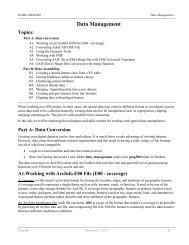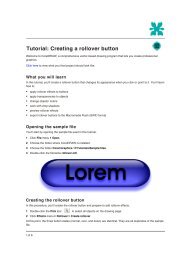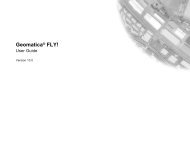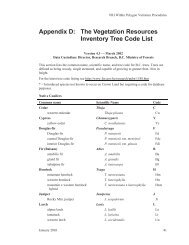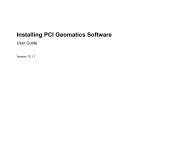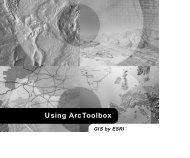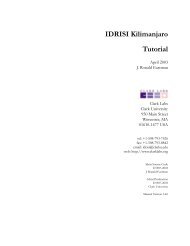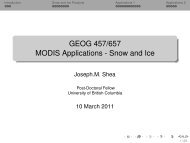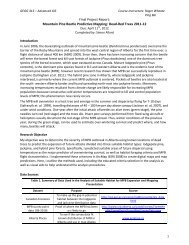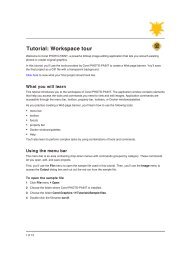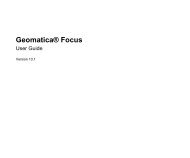Understanding Map Projections
Understanding Map Projections
Understanding Map Projections
You also want an ePaper? Increase the reach of your titles
YUMPU automatically turns print PDFs into web optimized ePapers that Google loves.
SIMPLE CONIC<br />
Equirectangular projection must be used.<br />
Use Equirectangular if the standard parallel is the<br />
equator.<br />
LINES OF CONTACT<br />
Depends on the number of standard parallels.<br />
Tangential projections (Type 1)—One line, indicated<br />
by the standard parallel.<br />
Secant projections (Type 2)—Two lines, specified as<br />
first and second standard parallels.<br />
LINEAR GRATICULES<br />
All meridians.<br />
PROPERTIES<br />
The central meridian is 60° W. The first and second standard<br />
parallels are 5° S and 42° S. The latitude of origin is 32° S.<br />
DESCRIPTION<br />
Also called Equidistant Conic or Conic.<br />
This conic projection can be based on one or two<br />
standard parallels. As the name implies, all circular<br />
parallels are an equal distance from each other,<br />
spaced evenly along the meridians. This is true<br />
whether one or two parallels are used.<br />
PROJECTION METHOD<br />
Cone is tangential if only one standard parallel is<br />
specified and secant if two standard parallels are<br />
specified. Graticules are evenly spaced. The space<br />
between each meridian is equal, as is the space<br />
between each of the concentric arcs that describe the<br />
lines of latitude. The poles are represented as arcs<br />
rather than points.<br />
If the pole is given as the single standard parallel,<br />
the cone becomes a plane and the resulting<br />
projection is the same as a polar Azimuthal<br />
Equidistant.<br />
If two standard parallels are placed symmetrically<br />
north and south of the equator, the resulting<br />
projection is the same as Equirectangular, and the<br />
Shape<br />
Local shapes are true along the standard parallels.<br />
Distortion is constant along any given parallel.<br />
Distortion increases with distance from the standard<br />
parallels.<br />
Area<br />
Distortion is constant along any given parallel.<br />
Distortion increases with distance from the standard<br />
parallels.<br />
Direction<br />
Locally true along the standard parallels.<br />
Distance<br />
True along the meridians and the standard parallels.<br />
Scale is constant along any given parallel but<br />
changes from parallel to parallel.<br />
LIMITATIONS<br />
Range in latitude should be limited to 30 degrees.<br />
USES AND APPLICATIONS<br />
Regional mapping of midlatitude areas that have a<br />
predominantly east–west extent.<br />
Common for atlas maps of small countries.<br />
Used by the former Soviet Union for mapping the<br />
entire country.<br />
82 • <strong>Understanding</strong> <strong>Map</strong> <strong>Projections</strong>




